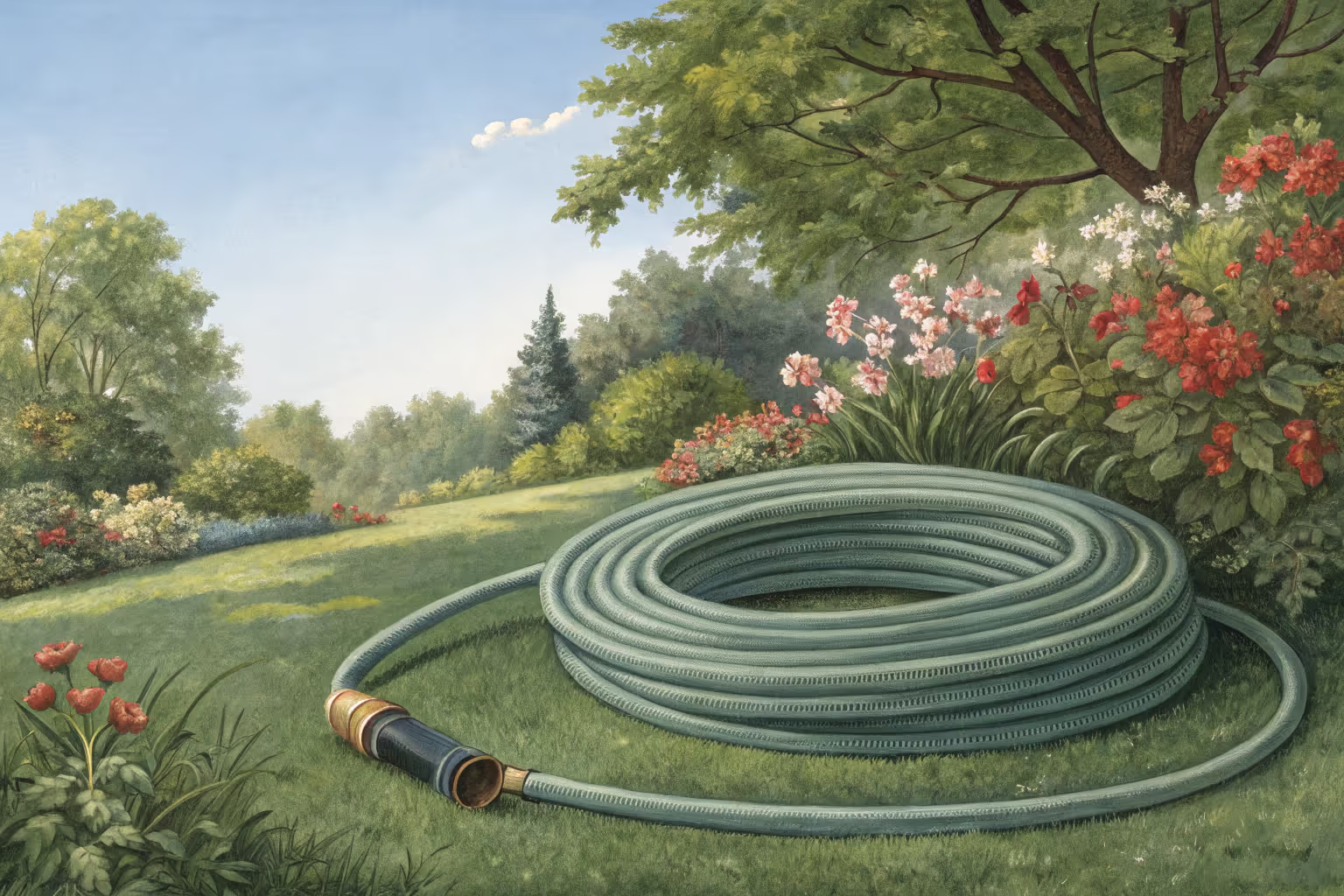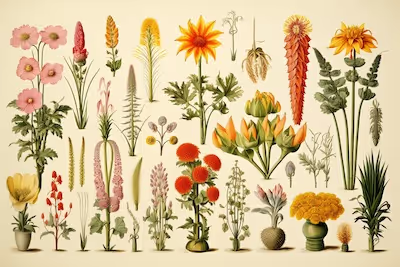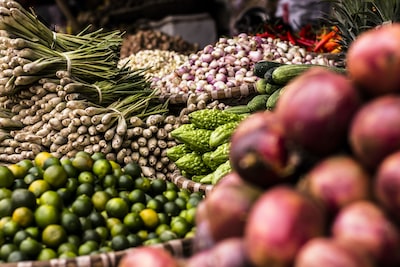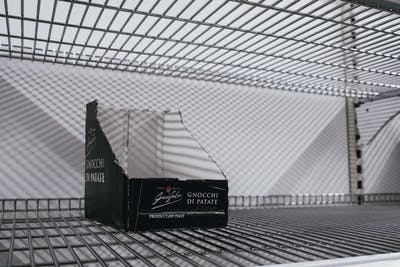Garden Hose Tips for Healthier Vegetable Garden Growth

Garden hose
A simple garden hose delivers more than hydration—it can boost veggie growth, control pests, and stimulate roots. Adjusting a garden hose nozzle to mist tender seedlings reduces shock, while a firm spray dislodges aphids without chemicals. Coiling a sun-warmed garden hose around planting beds gently warms soil for early vegetables—curious gardeners, read on for more unexpected veggie-growing tricks.
Cheatsheet: Hose Mastery for Thriving Veggie Beds
🛠️ Tools and products you'll need
- Drinking-safe hose (lead-free, BPA-free)
- Sprayer nozzle with gentle/shower mode
- Soaker hose or drip line (for consistent watering)
- Quick-connect fittings
- Hose reel or hanger
💧 Water Quality & Hose Choice
- Untreated water yields 30% higher plant health
- Avoid vinyl hoses: leach chemicals
- Flush hose 1-2 min before each use (removes stagnant water, heat buildup)
- Check for lead-free, food-safe labeling
🌱 Proper Watering Method
- Water early: Sunrise (max absorption, avoids fungus)
- Soil, not leaves: Wetting foliage invites mildew
- Apply 1–1.5" (2.5–4cm) per week total (rain + hose)
- Deep soak roots; shallow watering stunts growth
- Check 2" (5cm) down—moist, not soggy
🔥 Heat & Sun Hose Safety
- Never use water that's been sitting in sun-exposed hose—temps reach 130°F (55°C), damaging roots/nutrients
- Store hose in shade; use a reel or cover
- Flush hot water before irrigating crops
⏳ Efficiency Hacks
- Install quick-connects for faster setup
- Use soaker hoses for root-level irrigation; saves up to 50% water
- Mulch beds to retain moisture; reduces hose use
- Set a timer: 10–20 min per bed (soil-dependent)
🥕 Health & Nutrition Boost
- Consistent, clean water = up to 20% higher vitamin C in tomatoes
- Reduce plant stress for stronger, tastier, more self-sufficient harvest
🔍 Hose Maintenance
- Check for leaks each month—1 drip/min wastes 34 gal (129 L) a year
- Drain and coil after use to prevent bacteria buildup
- Disinfect nozzle monthly to stop mold
Garden hose tips for healthier vegetable garden growth
I learned fast that a Garden hose can grow tomatoes as much as any compost pile can. The right hose, pressure, and timing turn thirsty vines into steady producers.
Start with water safety, because hoses sit in the sun and stew. Choose drinking‑water‑safe hose materials labeled lead‑free, BPA‑free, and compliant with NSF/ANSI 61 or equivalent.
"Outdoor water use can account for about 30 percent of household use nationwide, and much more in summer" (EPA WaterSense).
Older vinyl hoses have tested high for lead and phthalates in Consumer Reports evaluations. I retired every opaque, cheap vinyl coil on my property after reading those results and tasting the plastic on a hot July morning.
Sizing: diameter, length, and flow that actually reaches roots
Pick diameter for distance and flow, then buy the shortest length that still reaches your furthest bed. A 5/8 in hose moves more water with less pressure loss than 1/2 in, and 3/4 in shines on long runs over 75 ft (23 m).
Typical spigots sit at 40 to 60 psi, but friction in a hose eats pressure. Expect about 15 psi loss per 100 ft (30 m) for 1/2 in at moderate flow, around 6 psi for 5/8 in, and roughly 2 psi for 3/4 in.
I run 3/4 in main hose to the garden, then short 5/8 in feeders to beds. That keeps my rose wand gentle without starving the flow to a soaker loop.
Nozzles, wands, and shutoffs that save plants and wrists
Use a long watering wand with a fine rose pattern for seedlings and greens. A brass fireman‑style nozzle blasts soil structure, so I reserve it for cleaning tools and hardscape.
Add an inline brass shutoff at the hose end. It saves a dozen trips to the spigot and lets you feather flow as you move down a row.
Soaker hose and drip: the quiet workhorses
Soaker hoses and drip lines feed the root zone without wet leaves, which trims disease pressure. Install a filter and a pressure regulator set between 10 and 25 psi for soaker, 15 to 30 psi for drip emitters.
Lay soaker runs 12 to 18 in (30 to 45 cm) apart in loam, closer in sand, wider in clay. Cover with 2 to 3 in (5 to 7.5 cm) mulch to curb evaporation and temper soil heat.
"Water early in the day to reduce evaporation and leaf diseases" (University extension guidance is remarkably consistent here, from UC IPM to Cornell).
I water raised beds at dawn, then let the sun dry any stray splash. Overhead watering in the evening gave me the worst septoria outbreak of my life on tomatoes.
Timing, depth, and the bucket test
Vegetables usually thrive with about 1 in (25 mm) of water per week, a bit more in heat waves. That equals about 0.623 gallons per square foot (2.36 L per 0.09 m²).
Measure your hose flow with a 5‑gallon bucket. If it fills in 45 seconds, your flow is 6.7 gpm and you can time bed watering with less guesswork.
Water to 6 to 8 in (15 to 20 cm) depth for lettuce and beans, 12 in (30 cm) for peppers, and 18 to 24 in (45 to 60 cm) for tomatoes. I use a soil probe and stop when the top few inches darken and cool to the touch.
Water temperature and the first flush
Hose water left in full sun can spike near 130 F (54 C). I dump the first 1 to 2 gallons (3.8 to 7.6 L) onto paths before touching edibles or seedlings.
That quick purge also clears biofilm fragments. Clean, cool water keeps root hairs happy and reduces transplant shock.
Backflow protection and filters
Thread a vacuum breaker at the spigot to prevent siphoning hose water back into house lines. Many municipalities require it, and it costs less than a flat of basil starts.
Add a Y‑splitter with ball valves, then a 150‑mesh filter before any drip or soaker hardware. Sediment from old pipes clogs emitters faster than you think.
Materials, fittings, and what I actually buy
- Polyurethane, drinking‑water‑safe: light, low memory, tasteless water; great for edibles; 50 ft (15 m) often weighs under 5 lb (2.3 kg).
- Rubber/EPDM: durable in cold, flexible below 40 F (4 C), resists kinks; a bit heavy for long hauls.
- Hybrid polymer: good balance of flexibility and weight; better in sun than plain PVC.
- Vinyl/PVC: inexpensive, but coils stiffen, fittings crack, and many lack safe‑water certification.
- Expandable hoses: handy for patios, but low burst strength and weak fittings limit garden duty.
Look for crush‑proof metal couplings, strain relief springs, and a burst rating above 300 psi. Standard threads are 3/4 in GHT with 11.5 TPI, and a fresh rubber washer fixes most drips.
Care, storage, and the end of kink season
Uncoil fully and let water push out twists, then coil in large loops about 3 ft (0.9 m) across. I hang hoses in the shade or on a reel, drained, with ends joined to keep spiders and grit out.
In winter, open the low end and walk the hose to purge every pocket of water. Freeze‑split hoses taught me that lesson twice.
Sanitizing and algae control
If a hose smells swampy, I sanitize with 1 tablespoon unscented household bleach per gallon of water (15 mL per 3.8 L), dwell 10 minutes, then flush until you smell nothing. Do this before peak season and after long storage.
Opaque hoses block light and slow algae. Clear hoses grow an ecosystem you did not order.
Pressure problems and quick fixes
- Low flow at the end of a long run: increase hose diameter upstream or shorten the run.
- Uneven soaker output: regulate pressure, level the lines, and cap the end to build uniformity.
- Leaky couplings: replace the washer and hand‑tighten; pliers chew threads and cause chronic drips.
- Kinks near the faucet: add a 2 ft (0.6 m) leader hose with a swivel to reduce twist.
Watering strategy by soil type
- Sand: shorter, more frequent sets; soaker spacing 8 to 12 in (20 to 30 cm).
- Loam: moderate sets; spacing 12 to 18 in (30 to 45 cm).
- Clay: slower, deeper sets to prevent runoff; spacing 18 to 24 in (45 to 60 cm).
I throttle flow until the soil accepts water without pooling. A paused set midway lets water infiltrate and reach deeper roots.
Top picks and price ranges by use case
- Edible gardens, main hose: 5/8 in drinking‑water‑safe polyurethane, 50 to 100 ft; expect 70 to 120 USD for 50 ft (65 to 110 EUR).
- Long runs or manifolds: 3/4 in rubber or hybrid polymer, 50 to 75 ft; 80 to 150 USD (75 to 140 EUR).
- Bed‑level watering: 1/2 in soaker hose with 10 to 25 psi regulator; 25 to 45 USD per 50 ft (23 to 42 EUR).
- Patio pots: lightweight polyurethane coil hose with a wand; 30 to 60 USD (28 to 55 EUR).
- Fittings: brass quick‑connects, vacuum breaker, Y‑splitter, and shutoff valve; bundle total 30 to 70 USD (28 to 65 EUR).
I buy once for the main hose, then cheap out on short leaders I abuse. The leaders take the scuffs, and the good hose lives longer.
Disease reduction and leaf hygiene
Keep foliage dry and you’ll see fewer blights on tomatoes and mildews on cucurbits. I water at soil level and give overhead a pass except for seedbed crusting.
Avoid blasting bare soil, which collapses pore space and suffocates roots. A soft face on the wand preserves tilth and saves you tilling penance later.
Safety notes gardeners actually use
- Flush hot hose water before irrigating edibles or filling pet bowls.
- Use a dedicated, food‑safe hose for the vegetable plot and label it plainly.
- Keep hoses out of traffic paths to prevent fitting damage and ankle breakers.
- Check local codes for required backflow devices on outdoor faucets.
Numbers that guide my week
I aim for 1 inch (25 mm) per week split into two deep sets in heat, one in mild weather. In a 4 by 8 ft bed, that’s about 20 gallons (76 L) per week, confirmed with the bucket test.
If rain brings half an inch (13 mm), I cut my hose time in half. Overwatering lures fungus gnats and starves roots of air.
Field notes from the hose end
On a 104 F (40 C) afternoon, I found seedlings wilting even with moist soil, so I misted the air above the bed for 30 seconds to drop leaf temps. Then I returned at dawn to finish deep watering when the plants could actually drink.
That tiny thermal tweak saved a flat of chiles. The garden rewards observation more than gadgets.
Citations I trust
- EPA WaterSense: outdoor water use percentages and seasonal spikes.
- Consumer Reports: testing of garden hoses for lead and phthalates across multiple years.
- University extensions (UC IPM, Cornell, Minnesota): early morning irrigation and disease reduction, drip/soaker best practices.
- FAO and USDA references on crop water needs and mulch reducing evaporation.
I keep those guides bookmarked and adjust for my microclimate. A good Garden hose and a better plan beat hauling cans and hoping for the best.

Want smarter plant choices? 🪴
Frequently Asked Questions on Veggie Growth and Your Garden Hose
How often should veggies feel the splash of my garden hose?
Water your vegetables deeply once or twice weekly. Frequent shallow sprinklings produce weak roots—soak the soil thoroughly, letting moisture seep down deeply to encourage strong, resilient growth. Early morning watering sessions bring out the best flavors and send pests scurrying.
Can spraying water directly onto veggie foliage boost plant vitality?
Misting leaves occasionally with the garden hose can refresh the plants and shake loose pesky aphids and mites. However, avoid turning foliage into a nightly wet party—damp leaves overnight invite fungus and mildew to take root.
What's the ideal pressure setting for garden hose watering?
A steady, gentle stream from your garden hose does the trick—forceful jets wound delicate stems and erode the soil. Opt for a soft shower setting to simulate nature's rainfall, nourishing your vegetables without battering them.
Does garden hose length impact watering efficiency?
Absolutely. Longer hoses decrease pressure, risking a weak dribble rather than an enthusiastic spray. Aim for shorter, moderate-length hoses that provide consistent water flow, ensuring vegetables receive the thorough soaking they crave.
Should I use cold or lukewarm garden hose water for sensitive veggies?
Veggies thrive best with water matching ambient garden temperatures. Sun-heated hose water can scorch delicate leaves; overly cold blasts shock roots. Let initial heated water flow out before gently saturating your precious harvest.
Put simply, your garden hose is more than a tool—it’s the lifeline connecting you to your vegetables. Choose wisely, keep it clean, and water with care. Early morning or late afternoon, deep soaking beats a quick sprinkle every time. Mind the pressure; don’t blast delicate seedlings into oblivion. Coil your hose neatly to avoid kinks, and store it out of the sun to keep it supple. If you’re tired of dragging heavy hoses, a trusty wheelbarrow can save your back. And if your plants still struggle, check out why vegetable plants keep dying for troubleshooting.
Remember: healthy soil, steady watering, and the right garden hose habits set your patch up for real growth. Take care of your gear, and it’ll take care of your harvest.
The Prepper's Guide to Garden Hose Adaptations
Emergency Hydration Techniques
- Solar Sterilization: Fill garden hose with clear water, seal ends, expose to direct sunlight for 6 hours at 86°F (30°C) to sterilize bacteria and pathogens.
- Gravity-fed Water System: Situate hose at an elevated location (3 ft / 0.9 m minimum) above ground-level containers for continuous freshwater flow without pumps.
- Hose Filtering: Attach portable in-line water filter to hose output to reliably remove 99.9% harmful pollutants and pathogens.
Hose-powered Vertical Gardens
- Self-Watering Irrigation Tower: Coil a hose vertically within a perforated pipe stuffed with compost, providing moisture directly to root systems; conserves water usage by 60%.
- Hydropower Micro-generator: Connect hose to a micro-hydropower generator; steady hose water flow of 2 gal (7.6 L) per minute generates reliable emergency electricity for lighting and device charging.
Garden Hose for Food Preservation
- Rapid Cooling Coil: Submerge coiled garden hose in icy water and run harvested veggies through the cold hose interior; promptly lowers produce temperature, preserving nutrients and prolonging freshness.
- Hose-based Vacuum Sealing: Insert clean, sanitized hose end into food-safe vacuum bags, utilizing hose suction to remove air, effectively extending stored vegetable shelf-life by up to 4x.
Protecting Food Production in Extreme Conditions
- Frost Prevention Trick: Coil hose around key crops; fill with warm water (around 68°F / 20°C) at sunset, slowly releasing heat overnight, ensuring crops survive temperatures as low as 28°F (-2°C).
- Heatwave Relief: Mist plants through a nozzle attached hose twice daily during heat spells; ambient temperature around plants falls by 8-12°F (4-6.6°C), avoiding heat-induced stress.
Find out which plants will thrive in your garden!
Answer a few fun questions and get custom plant recommendations perfect for your space. Let’s grow something amazing together!

start your season





